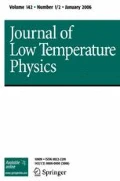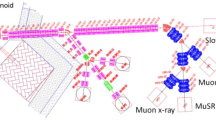Abstract
The Facility for Rare Isotope Beams (FRIB) was funded by the U.S. Department of Energy, which is the world’s most powerful isotope beam device. We have developed an 8T superconducting solenoid magnet which is used to focus and steer the heavy ion beams for FRIB Driver Linac. The solenoid consists of a main focusing coil, two shielding coils and two pairs of corrector dipoles, fabricated by NbTi wire only. A helium vessel was designed and fabricated to accommodate the coils with an entire length of 652 mm with end flange. The magnet in an operating current of 89.6 A achieved the maximum magnetic field of 8T in 40-mm cold bore without quench. In this paper, the overall design of the whole magnet was introduced, including the magnetic design, mechanical design, quench simulation and the protection circuit. Moreover, the winding process and the test results were showed.












Similar content being viewed by others
References
K. Hosoyama et al., Superconducting solenoid package prototyping for FRIB SRF LINAC, in: Proceedings of IPAC, Richmond, VA, USA, 2005, pp. 2886–2888.
T. Yang et al., A compact superconducting solenoid for China-ADS injector II. IEEE Trans. Appl. Supercond. 26(4), 4004105 (2016)
K. Wilcken, D. Fink, M. Hotchkis, D. Garton, D. Button, M. Mann, R. Kitchen, T. Hauser, A. O’Connor, Accelerator mass spectrometry on SIRIUS: new 6 MV spectrometer at ANSTO. Nucl. Instrum. Methods Phys. Res. Sect. B 406, 278–282 (2017)
X. Du, W. Wang, Design of superconducting magnet for 1.5 T dedicated extremity MRI system. IEEE Trans. Appl. Supercond. 24(3), 1–4 (2014)
F. Romeo et al., Magnetic field profiling analysis and correcting coil design. Magn. Reson. Med. 1, 44–65 (1984)
N. Schwerg, B. Auchmann, S. Russenschuck, Quench simulation in an integrated design environment for superconducting magnets. IEEE Trans. Magne. 44(6), 934–937 (2008)
V. Berland, D. Hagedorn, F. Rodriguez-Mateos, Testing of high current by-pass diodes for the LHC magnet quench protection. IEEE Trans. Magn. 32(4), 3094–3097 (2002)
E.S. Bobrov, J.E.C. Williams, Direct optimization of the winding process for superconducting solenoid magnets (linear programming approach). IEEE Trans. Magn. 17(1), 447–448 (1981)
Acknowledgements
The authors thank Mr. Xu and Mr. Earle from FRIB for their technical support, Wenjie Yang and Beiming Wu from IMP for their assistance in performing the cold test, Dr. K. Saito for helpful discussions.
Funding
Funding was provided by Key Technologies Research and Development Program (Grant No. 2017YFB0902303).
Author information
Authors and Affiliations
Corresponding author
Additional information
Publisher's Note
Springer Nature remains neutral with regard to jurisdictional claims in published maps and institutional affiliations.
Rights and permissions
About this article
Cite this article
Li, C., Zhang, P., Liang, C. et al. Design and Test of an 8T Focusing Superconducting Solenoid of FRIB Driver Linac. J Low Temp Phys 203, 194–203 (2021). https://doi.org/10.1007/s10909-021-02572-0
Received:
Accepted:
Published:
Issue Date:
DOI: https://doi.org/10.1007/s10909-021-02572-0



